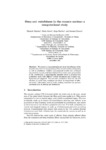Mostrar o rexistro simple do ítem
Sleep and wakefulness in the cuneate nucleus: a computational study
| dc.contributor.author | Sánchez Vila, Eduardo | |
| dc.contributor.author | Barro Ameneiro, Senén | |
| dc.contributor.author | Mariño Alfonso, Xurxo | |
| dc.contributor.author | Canedo Lamas, Antonio | |
| dc.date.accessioned | 2005-11-17T18:51:05Z | |
| dc.date.available | 2005-11-17T18:51:05Z | |
| dc.date.issued | 2003 | |
| dc.identifier.citation | 7th International Work-Conference on Artificial and Natural Neural Networks, IWANN 2003, Menorca, Spain, June 3-6, 2003 : proceedings, José Mira, José R. Álvarez (eds.). Lecture notes in computer science, vol. 2686 (2003), p. 70-77 | es_ES |
| dc.identifier.issn | 0302-9743 | |
| dc.identifier.uri | http://hdl.handle.net/2183/246 | |
| dc.description.abstract | We present a computational study about the influence of the sensorimotor cortex on the processing of the cuneate nucleus during sleep as well as wakefulness. Realistic computational models were developed supported by experimental data obtained from intact-brain preparations in cat. Furthermore, a physiologically plausible circuit is proposed and predictions under both different cortical stimulation and synaptic configurations are suggested. The computer simulations show that the CN circuitry (1) under sleep conditions can block the transmission of afferent sensory information, and (2) under awaking conditions can perform operations such as filtering and facilitation. | es_ES |
| dc.format.mimetype | application/pdf | |
| dc.format.mimetype | text/plain | |
| dc.language.iso | eng | es_ES |
| dc.publisher | Springer | es_ES |
| dc.rights | The original publication is avaliable at www.springerlink.com | es_ES |
| dc.rights | The original publication is avaliable at www.springerlink.com | |
| dc.title | Sleep and wakefulness in the cuneate nucleus: a computational study | es_ES |
| dc.type | info:eu-repo/semantics/article | es_ES |
| dc.rights.access | info:eu-repo/semantics/openAccess | es_ES |
Ficheiros no ítem
Este ítem aparece na(s) seguinte(s) colección(s)
-
GI-NEURO - Artigos [160]






